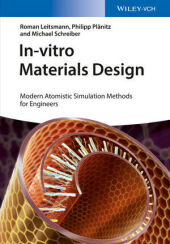 Neuerscheinungen 2015Stand: 2020-02-01 |
Schnellsuche
ISBN/Stichwort/Autor
|
Herderstraße 10
10625 Berlin
Tel.: 030 315 714 16
Fax 030 315 714 14
info@buchspektrum.de |

Roman Leitsmann, Philipp Plänitz, Michael Schreiber
(Beteiligte)
In-vitro Materials Design
Modern Atomistic Simulation Methods for Engineers
1. Auflage. 2015. X S. 100 SW-Abb., 20 Farbabb. 244 mm
Verlag/Jahr: WILEY-VCH 2015
ISBN: 3-527-33423-8 (3527334238)
Neue ISBN: 978-3-527-33423-0 (9783527334230)
Preis und Lieferzeit: Bitte klicken
Ein praxisrelevanter Überblick über die aktuellsten computergestützten Simulationsmethoden in den Materialwissenschaften - unentbehrlich für moderne, anwendungsorientierte Materialforschung!
I. BASIC PHYSICAL AND MATHEMATICAL CONCEPTS
Newtonian Mechanics and Molecular Dynamics
Operators and Fourier Transformations
Bravais Lattice and k-Space
Introduction to Quantum Mechanical Concepts
II. COMPUTATIONAL METHODS
Classical Simulation Methods:
Simple Force Field Methods
Reactive Force Field Methods
Quantum Mechanical Simulation Methods:
Hartree-Fock (HF) Method
Density Functional Theory (DFT)
Concepts beyond HF and DFT
Multiscale Approaches
III. INDUSTRIAL APPLICATIONS
Tribological Properties
Intercalation of Ions in Electrode Materials
Nano-Structured Materials
Chemical Reactions in Porous Materials
Leakage Current in Integrated Circuits
In-vitro Materials Design provides an overview of the latest computational materials science methods on an atomic scale, covering real-life applications taken from concrete projects that range from tribology modeling to performance optimization of integrated circuits.
An overview of the latest computational materials science methods on an atomic scale.
The authors present the physical and mathematical background in sufficient detail for this highly current and important topic, but without unnecessary complications. They focus on approaches with industrial relevance, covering real-life applications taken from concrete projects that range from tribology modeling to performance optimization of integrated circuits.
Following an introduction to the fundamentals, the book describes the most relevant approaches, covering such classical simulation methods as simple and reactive force field methods, as well as highly accurate quantum-mechanical methods ranging from density-functional theory to Hartree-Fock and beyond. A review of the increasingly important multiscale approaches rounds off this section. The last section demonstrates and illustrates the capabilities of the methods previously described using recent real-life examples of industrial applications. As a result, readers gain a heightened user awareness, since the authors clearly state the conditions of applicability for the respective modeling methods so as to avoid fatal mistakes.


